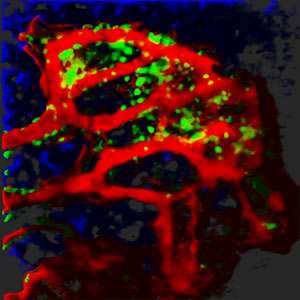A mouse strain gives the most detailed visualization yet of immune cells in the bone marrow

White blood cells called monocytes, that play a vital role in stable immune responses, can now be visualized over time inside the bone marrow using a new reporter mouse developed by A*STAR researchers.
Monocytes mediate inflammation and trigger the body's defense mechanism in response to injury and disease. From the bone marrow, monocytes are sent out into the bloodstream, where they differentiate into tissue macrophages—large cells that 'consume' pathogens. This process is accelerated during disease or infection, and its disruption is implicated in inflammatory diseases such as cancer.
Despite their critical role, little is known about how monocytes are recruited and mobilized in the body. The ability to view monocytes leaving the bone marrow over time would be invaluable (see image and video). To achieve this goal, A*STAR researcher Lai Guan Ng at the Singapore Immunology Network, and co-workers from institutions across Singapore, adopted multiphoton intravital microscopy, a deep-tissue imaging technique that picks up signals from the fluorescent tagging of specific cell types.
"Current approaches track monocyte recruitment using cell counting methods, and only provide static snapshots of what is happening," explains Ng. "In contrast, multiphoton intravital microscopy can monitor individual cells over time, revealing critical details and providing a comprehensive picture of the entire biological process."
Ng and his team tested three genetically-modified mice to determine the best reporter mouse for tracking monocytes. One of the mice, labeled Cx3cr1gfp/+, produced reasonable images of cell activity in the bone marrow. Dendritic cells—immunity messenger cells—were also tagged by the same fluorescent marker, leading to an unclear confused signal and difficulty in singling out individual monocytes.
"We realized we needed to create a new reporter mouse that labels fewer dendritic cells," says Ng. "We crossed the Cx3cr1gfp/+ reporter mouse with another strain that produces less dendritic cells. Using this crossbred mouse, we could visualize the monocytes in greater detail than ever before."
The team found that most monocytes mobilized in response to a trigger signal, such as molecules on the surface of bacteria. Some monocytes were unable to leave the bone marrow however, indicating a retention mechanism is at play. This mechanism may provide a pharmacological target that could mobilize cells from the bone marrow.
"Our approach could help us understand monocyte behavior in multiple diseases and metabolic conditions," says Ng. "It may also prove a powerful tool to address the efficacy of drugs targeting monocyte mobilization, and may be applied to other cell types involved in immunity in the future."
More information: M. Evrard et al. Visualization of bone marrow monocyte mobilization using Cx3cr1gfp/+Flt3L-/- reporter mouse by multiphoton intravital microscopy, Journal of Leukocyte Biology (2014). DOI: 10.1189/jlb.1TA0514-274R


















